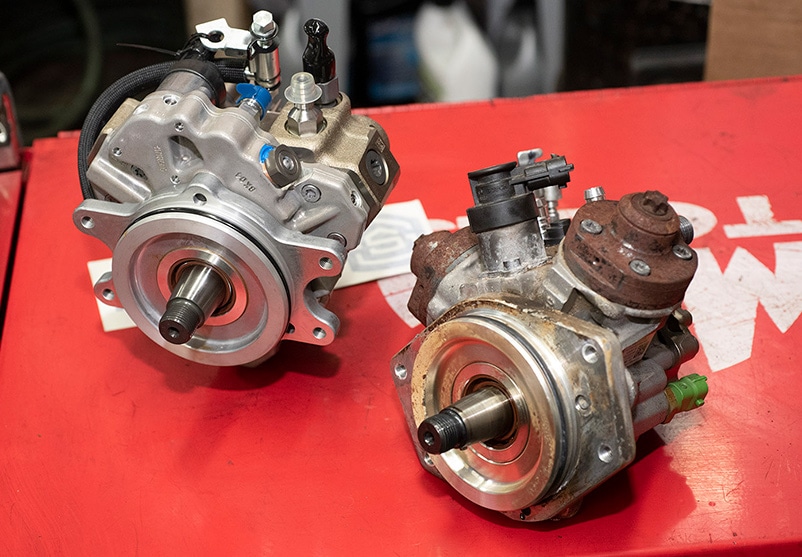APRIL 2019
Lift Pumps

I have a 2016 Ram 3500 Crew Cab dually with the 6.7-liter Cummins. It has just over 45,000 miles, most of it towing our 2017 Keystone Cougar 367FLS fiver. Several of my friends who are also full-time RVers say that installing an aftermarket “lift pump” on the Cummins is a good investment. What’s your opinion?
Charley Koontz, Kingman, Arizona
 Aftermarket lift pumps, such as those offered by FASS, PureFlow AirDog and FueLab, provide several benefits, even to stock diesel trucks. In fact, the aftermarket lift-pump manufacturer FASS aptly stands for what a lift pump does: Fuel Air Separation System. It purges the fuel of contaminants, water, air and vapor from the fuel pulled from the fuel tank before pushing it on up the fuel line to the high-pressure fuel-injection pump.
Aftermarket lift pumps, such as those offered by FASS, PureFlow AirDog and FueLab, provide several benefits, even to stock diesel trucks. In fact, the aftermarket lift-pump manufacturer FASS aptly stands for what a lift pump does: Fuel Air Separation System. It purges the fuel of contaminants, water, air and vapor from the fuel pulled from the fuel tank before pushing it on up the fuel line to the high-pressure fuel-injection pump.
Clean fuel is critical in today’s diesels. The smallest containment making its way through to the injection pump can create big problems with injectors operating properly, causing performance and premature injector wear issues. Most aftermarket lift pumps filter fuel far better than the OEM fuel-filter system.

This illustration from FASS shows how the company’s lift pump operates, pulling fuel from the tank, purging it from water, vapor and contaminants, then pushing it on toward the truck’s high-pressure fuel-injection pump. Courtesy of FASS.
Just as important is that fuel be free of any air or vapor. Aftermarket lift pumps do an excellent job making sure diesel fuel is free of both. Any air in the fuel leads to loss of lubrication to the CP3, or any other fuel-injection pump. Diesel fuel is the lubricant to all the injection-related parts.
Air in the fuel system, whether from running your fuel tank too low or, say, a tiny leak in the fuel-feed-line connection between the tank and the factory fuel filter, is not good. That’s why diesel technicians say it’s never smart to let your diesel truck’s fuel tank drop below a quarter tank.
The last benefit of a lift pump is that it pressurizes the fuel as it exits the lift pump, which helps the longevity of the injection pump. Without a lift pump, the factory injection pump, like the CP3 in your Cummins 6.7, has to suck the fuel all the way from the fuel tank through the filter system and into the chambers in the pump where the fuel pressure is raised around 30,000 psi before pushing it on to the fuel rails and into the injectors. An aftermarket lift pump takes that “lifting” load off the CP3, increasing both its efficiency and longevity.
As for the higher flow capacity a lift pump brings to the table, that has no bearing on increasing power or improving fuel economy when installed on a stock engine because the fuel flow to the injectors is controlled and/or limited by the injection pump. But a lift pump will provide the additional fuel flow needed if you add a bigger turbo and injectors.
Final Thought
Installing an aftermarket lift pump is a good “preventive maintenance” upgrade for your Ram Cummins, as well as 2011 to 2016 GM Duramax and Ford Power Strokes that use the Bosch CP4.2 fuel-injection pump, or any diesel pickup application in the last decade.

Diesel fuel-injection pumps, such as the CP3 (left) and CP4.2 (right), require clean, air-free fuel for the entire injection system to operate properly and to promote longer operating life of the pump and injectors. Photo by Bruce W. Smith
Join the Conversation
Scroll down to the Leave a Reply box to add your comments to this discussion.
Have a Diesel Tech Question?
To ask Bruce W. Smith a question about maintenance, repairs or upgrades to your diesel truck, SUV or van, go to the Diesel Tech Q&A home page, scroll down to the Leave a Reply box and type in your question. Please include your full name and hometown.
 A respected automotive and RV journalist and longtime Trailer Life contributor, Bruce W. Smith has held numerous editorial titles at automotive and boating magazines, and authored more than 1,000 articles, from tech to trailering. He considers his home state of Oregon a paradise for RVing and outdoor adventure.
A respected automotive and RV journalist and longtime Trailer Life contributor, Bruce W. Smith has held numerous editorial titles at automotive and boating magazines, and authored more than 1,000 articles, from tech to trailering. He considers his home state of Oregon a paradise for RVing and outdoor adventure.
Read More: Diesel Tech Q&A
See Related Column: RV Clinic

